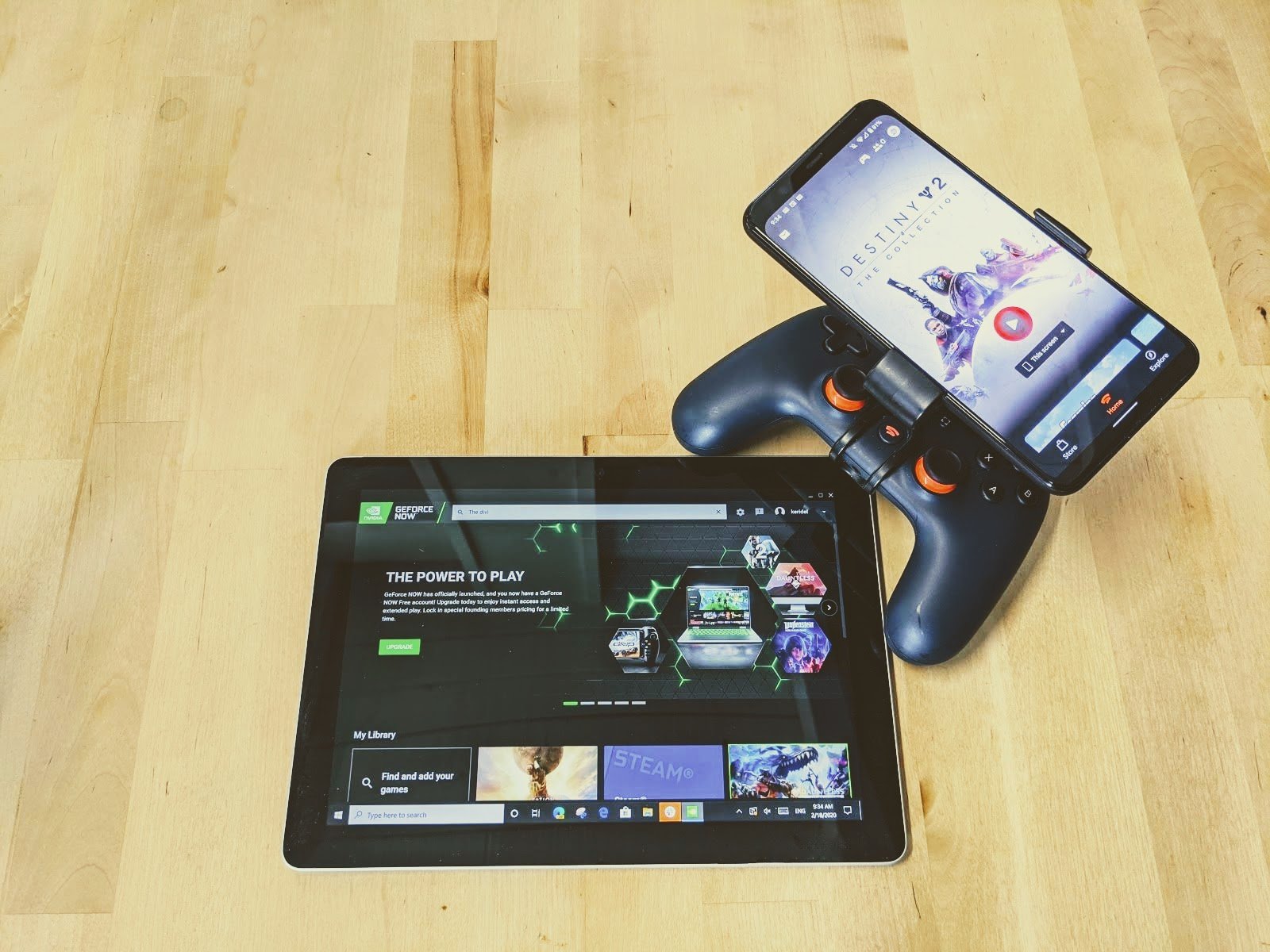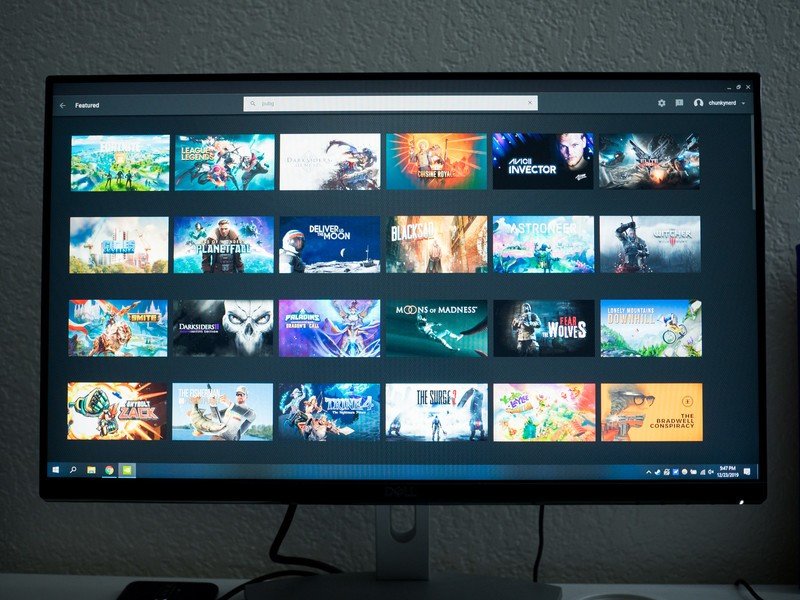GeForce Now vs. Google Stadia: Which should you buy?

GeForce Now

GeForce Now uses your library to give you the games you want to play and already own streamed to just about any device you can imagine, for a price that seems fitting for a new service. Playing Destiny 2 on GeForce Now feels no different than playing on the PS4.
GeForce Now
Your games, anywhere
Stadia

The Stadia controller is impressive, and the potential of the service is writ large in some of its features. Since it's launch, Stadia has expanded its list of games and compatible devices, making it a more than servicable streaming option for fans.
Stadia
Hey Google, play games
While Stadia benefits significantly from the server expertise of Google, the fact that GeForce Now works with games you already own and have available to you, that might be the best option for players who already have a ton of games on Steam or elsewhere. Given a choice, I would spend my money on Geforce Now, not Stadia.
GeForce Now vs. Google Stadia: Streaming services are a whole new ball game
Streaming services like Stadia, GeForce Now, and XCloud (now referred to as Xbox cloud gaming) are still in their infancy, but with Stadia and GeForce Now released as fully realized software, it seems fair to compare the two. I have spent hundreds of hours on these two platforms, and I've been using the same hardware for each.
My tests were done on a Surface Go with 4GB of RAM using an Xbox One S controller, and a Pixel 4 XL attached to the Stadia controller. Both tests were done on my one-gigabit internet, with average up/down speeds of 548Mbps/523Mbps. I've also tried both out on my Verizon LTE network with mixed results.
Because Destiny 2 is available on both services — one purchased through Stadia, one through Steam — and has cross-save, I spent a lot of my time playing it for this test. Being able to use the same character on both systems removed that as a variable, and it allowed me to play the same game modes in a repeatable way.
Now let's see how they both stack up.
Be an expert in 5 minutes
Get the latest news from Android Central, your trusted companion in the world of Android
GeForce Now vs. Google Stadia: The results

When looking at a game streaming service, the most crucial thing to consider is latency and controller input lag. To be effective, a streaming service must be able to operate with the same input lag as a traditional console or to be so close as to be indistinguishable.
Stadia deals with delays in a very smart way. Stadia controllers connect directly to your Wi-Fi when you play on a Chromecast. This removes one step in the process and allows the controller to talk directly to Google servers. When you aren't using the Stadia controller, the system works more traditionally — the signal is sent via Bluetooth to your PC, which sends it to the server and back — but any lag isn't noticeable in either configuration.
GeForce Now uses the traditional way to send information, which could add some input lag. However, GeForce Now reduces the resolution long before any delay appears in the game. The resolution drop can be dramatic when you are playing in 2K and the game suddenly drops to 720p or lower.
Of course, the fact that I have better internet than most means I suffer far less lag than others. However, my colleague over at Windows Central has much slower internet speeds than I do and found that Stadia still had less lag than GeForce Now most of the time. On the other hand, I found that game stutter occurs more frequently with Stadia than with GeForce Now, so instead of input lag, the whole game locks up. This is especially frustrating when you are mid-battle.
| Header Cell - Column 0 | Stadia | GeForce Now |
|---|---|---|
| Initial cost | $90 for the Premiere Edition | Free for 1 hour gaming sessions |
| Monthly cost | $10 a month for Stadia Pro | $5 a month for Founder's edition |
| Free tier | ✅ | ✅ |
| Internet requirements | 5Mbps for 720p/60fps, 20Mbps for 1080p/60fps | 15Mbps for 720p/60fps, 25Mbps for 1080p/60fps |
| Processing power | 10.7 teraflops | 12 teraflops |
| Max resolution | 4K | 2K |

The other significant factor in game streaming is likely to be the games catalog. GeForce Now is somewhat unique in the streaming world as it uses multiple accounts to find the games you already own. You can connect to Steam, Uplay, Epic, and even Origin, and use many of the games you already own from there. NVIDIA doesn't let you play all your games just yet, but more are added all the time, with the ultimate goal to have all of your games accessible anywhere. Essentially, GeForce Now makes a virtual machine on a server, and you log in to each of your storefronts. From there you can install the games you own in those storefronts to the virtual machine on NVIDIA's servers.
It still blows my mind that the Stadia app... doesn't work in landscape mode when connected to a controller in a grip
Google, on the other hand, went for a walled garden approach, where you need to purchase another copy of the game to play it on Stadia. This has the benefit of making the games completely compatible with the Stadia platform while increasing the cost to the consumer. While Google Stadia does offer a free tier that gives users access to cloud gaming on their devices, playing games still requires users to purchase them through Stadia.
Graphically there is very little difference between the two services. While Stadia is capable of playing at 4K, GeForce Now can only do 2K. I played with both on a 4K television, but to my eye, both look amazing at their full resolutions. Even if the GeForce Now resolution is upscaled, rather than native 4K, it stills looks fantastic, and if you opt for the paid tier on Now you'll get some sweet ray tracing on games that support it.
Both services have an app to help you use them on the phone, and while the GeForce Now app looks less appealing than the Stadia one, it allows you access to the games you need and it works in landscape mode. It still blows my mind that the Stadia app — made by the company that invented Android apps — doesn't work in landscape mode when connected to a controller in a grip. Once the game is launched, it plays in landscape, but the app itself is portrait only. Maddening.
It's important to note that Google said that Stadia is getting a lot more features in the future but they aren't here yet. Being able to watch a YouTube video of a game, buy that game from the video, and start playing immediately is going to be a huge deal. The integration with Google Assistant should also be game-changing; you'll be able to ask a question about the game and get the answer, while still playing, all from your controller. Even the ability to press the screenshot button and share it straight to social media is going to be great once it finished.
However, none of these features exist right now. They're just promises from Google of what might happen in the future. This makes it hard for me to recommend Stadia over GeForce Now, at least at the moment.
GeForce Now vs. Google Stadia: Which should you buy?

Right now, I can't in good conscience recommend Google Stadia. Even though the game load times are almost nonexistent, and the 4K experience is beautiful, there are just too many issues with it to make it viable. Paying $10 a month for a half-baked service, then paying full price for the games themselves, isn't worth it. There is plenty of room for Stadia to grow, and significant changes have been made, but at the time of writing, Stadia is not the winner.
Right now, I can't in good conscience recommend Google Stadia; there are just too many issues with it to make it viable right now.
GeForce Now has worked consistently for me every single time. No matter what hardware I choose, Now works precisely as it should. Right now, the game selection is small — though still more extensive than the Stadia collection — the biggest selling point is that the games on Now are your games already. You have access to the games you already own, with the community of players you already know, and that makes all the difference.
Playing any multiplayer activity on Destiny 2 from Google Stadia is impossible; there just aren't enough players. GeForce Now, though, has all of the PC players available to you as if you were playing from a local machine. This means hundreds, if not thousands, of players online at any given moment. It makes all the difference.
Now is the time to get onboard with GeForce Now, too, since NVIDIA is offering a Founders tier at just $5 a month — half the cost of Stadia — that includes ray tracing, priority access to games, and a six-hour session length. By comparison, the free tier — which Stadia still does not have — offers a first-come, first-served system on playing games and only a one-hour session time. That one hour seems limiting, although there is nothing stopping you from logging out and straight back in again to continue playing.
I spent a lot of time on Destiny 2 in GeForce Now and the only thing I couldn't do was the game's six-player raids, and right now I could spend just $60 — the price of one game — to be able to play for an entire year. It's just too good to pass up.

So many choices
NVIDIA's cloud game streaming service is one of the best available today, delivering lag-free gaming at 1080p/60FPS. The fact that you can access NVIDIA's servers for free makes it an easy sell. Plus, paying for the monthly plan unlocks a number of features.


